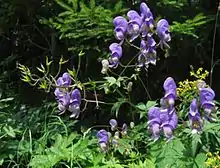Aconitum degenii
Aconitum degenii is a species of flowering plant in the buttercup family known by the common name branched monkshood .
| Aconitum degenii | |
|---|---|
 | |
| Aconitum degenii, inflorescence | |
| Scientific classification | |
| Kingdom: | Plantae |
| Clade: | Tracheophytes |
| Clade: | Angiosperms |
| Clade: | Eudicots |
| Order: | Ranunculales |
| Family: | Ranunculaceae |
| Genus: | Aconitum |
| Species: | A. degenii |
| Binomial name | |
| Aconitum degenii | |
| Synonyms | |
|
Aconitum camarum[1] | |
Distribution
This wildflower is native to Europe (south, south-east) where it grows in subalpine areas. Inhabited biotops include tall herbaceous vegetation and deciduous forests.[2]
Description
Aconitum degenii is a tall spindly erect to scandent forb which is perennial from rhizomes. It has divided leaves. The flowering period extends primarily from July to September. The inflorescence is paniculate and branched. The perigon is blue or purple. The helmet is about as high as it is wide or less high. The nectar leaves have a curved stem. The spur is slightly bent back. The plant reaches a stature height between 0.5 and 2.5 m. The pollination is done by insects (Bombus spec. and others). The fruits are pod-like follicles.[2] Aconitum degenii is poisonous due to the presence of alkaloids like aconitine.
Subspecies
Currently 2 subspecies are accepted:[1]
- Aconitum degenii subsp. paniculatum (Arcang.) Mucher
- Aconitum degenii subsp. valesiacum (Gáyer) Mucher
References
- The Plant List (KEW): Aconitum degenii (2018-04-03)
- Jäger et al.: Rothmaler - Exkursionsflora von Deutschland, Bd. 2. Aufl. 20, Spektrum akadem. Verlag.
External links